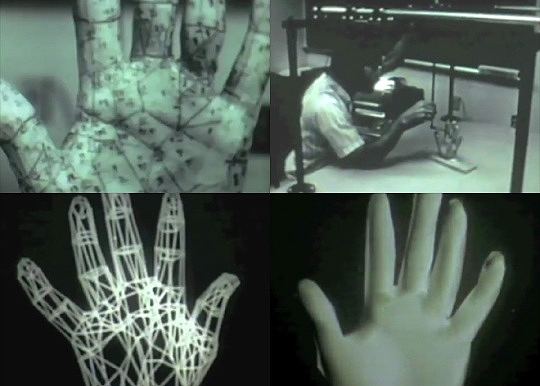A Computer Animated Hand
6 /10 1 Votes
Duration | Country United States | |||||||||||||||||||||||||||||||||
 | ||||||||||||||||||||||||||||||||||
Language Silent (intertitles in English) Director Edwin CatmullFred Parke Release date 1972 (1972) | ||||||||||||||||||||||||||||||||||
a computer animated hand 1972
A Computer Animated Hand is a 1972 American computer-animated film produced by Edwin Catmull and Fred Parke. Produced during Catmull's tenure at the University of Utah, the short was created for a graduate course project. After creating a model of Catmull's left hand, 350 triangles and polygons were drawn in ink on the model. The model was digitized and laboriously animated in a three-dimensional animation program that Catmull wrote.
Contents
- a computer animated hand 1972
- A computer animated hand mano animada por ordenador
- Production
- Legacy
- References

The film consists of three sequences: the data output of the hand without lines, a halftone sequence that lacks smooth shading, and finally, the completed animation. The film depicts the hand swiveling, opening and closing, pointing at the viewer, and lastly, zooms to the inside of the hand. The clip also features animation of an artificial heart valve and human faces. Snippets of the film were used in the 1976 film Futureworld.

As one of the earliest examples of computer animation, the film has been hailed as groundbreaking and revolutionary. Catmull went on to become a co-founder of Pixar and President of Pixar and Walt Disney Animation Studios. In 2011, the film was inducted in the National Film Registry, labeled "culturally, historically, or aesthetically significant." Library of Congress scholars wrote: "In creating the film, Catmull worked out concepts that would become the foundation for computer graphics that followed."
A computer animated hand mano animada por ordenador
Production
Catmull hoped as a child to become a Disney animator but reversed his ideas in high school, ruefully concluding he lacked the ability to draw. He graduated from the University of Utah in 1969 with a degree in computer science and physics, taking a job at Boeing shortly afterward. His position was soon terminated in a mass layoff along with thousands of other employees. Catmull revised his idea of becoming an animator during this time, believing computers might allow him to animate.
Fred Parke, a fellow Ph.D. student in his class who helped produce the film, recalled that computer animation was "sort of on the lunatic fringe at that time. […] People were just barely to the point where they could get a computer to put out still images." It was obvious it would take years for the state of the art in computer hardware to catch up with this ambition, and there were multiple problems on the mathematical and programming side. Nevertheless, in 1972, Catmull took the opportunity to create the short animated clip for a graduate course project.
Catmull used his left hand as the basis for the clip, first creating a model of it. He began making a plaster-of-paris mold of his hand and accidentally pulled off the hair on the back of his hand while removing the mold. He then made a plaster model from the mold and drew 350 small triangles and polygons on the model in ink. Digital counterparts of these polygons would represent the surface of his hand in the computer.
Catmull and Parke spent much time crafting the film, measuring the coordinates of each of the corner points of the polygons and typed them into the machine with a Teletype keyboard. With a 3-D animation program Catmull wrote, they could reproduce the disembodied hand on a screen and make it move. During this time, Parke had created a computer animation of his wife's face as well, which is seen in the film.
Transferring the images to film was a task in itself. Because the display hardware never showed the entire image on screen at any one moment, Catmull could see a frame of his work only by taking a long-exposure Polaroid of the screen and looking at the snapshot. Once satisfied, he then shot the footage using a 35mm camera the department rigged to take photographs from a CRT screen. The film credits fellow student Bob Ingebresten for creating the 3-D titles.
Legacy
Professor Ivan Sutherland opened a line of communication with The Walt Disney Company to see whether Disney could be persuaded to use computer graphics in its production process for traditional animation. Sutherland brought Catmull to Disney to meet with executives, but Disney management was not interested in computer graphics at that time. Instead, they invited Catmull (to no avail) to help the Disney Imagineering team use computers to design a new ride - specifically, Space Mountain, a roller-coaster ride planned for the new Walt Disney World complex in Orlando, Florida. The clips were later used on a TV monitor in the 1976 science-fiction thriller Futureworld, about a futuristic theme park where androids are programmed to grant every guest’s wish.
Catmull would later go on to form his own Computer Graphics Lab, later contacted by George Lucas of Lucasfilm to bring computer graphics into the entertainment field. The Graphics Group, one third of the computer division at Lucasfilm, was later purchased in 1986 by Apple Computer co-founder Steve Jobs, and it was renamed Pixar. Pixar produced the world's first computer-animated feature film, Toy Story, in 1995, and has since become the world's dominant animation studio, producing a string of immensely commercially and critically successful films. Catmull has won four Academy Awards for his technical feats and helped create some of the key computer-generated imagery software animators rely on today.
The film has been labeled a landmark, being called revolutionary in both the art of animation and film. Craig Caldwell, senior research professor at the University of Utah, stated in 2011 that the film is groundbreaking because "it showed the potential of putting three-dimensional form in the computer." In 2011, the film was selected for preservation in the Library of Congress' National Film Registry, dubbed culturally, historically, or aesthetically significant."
